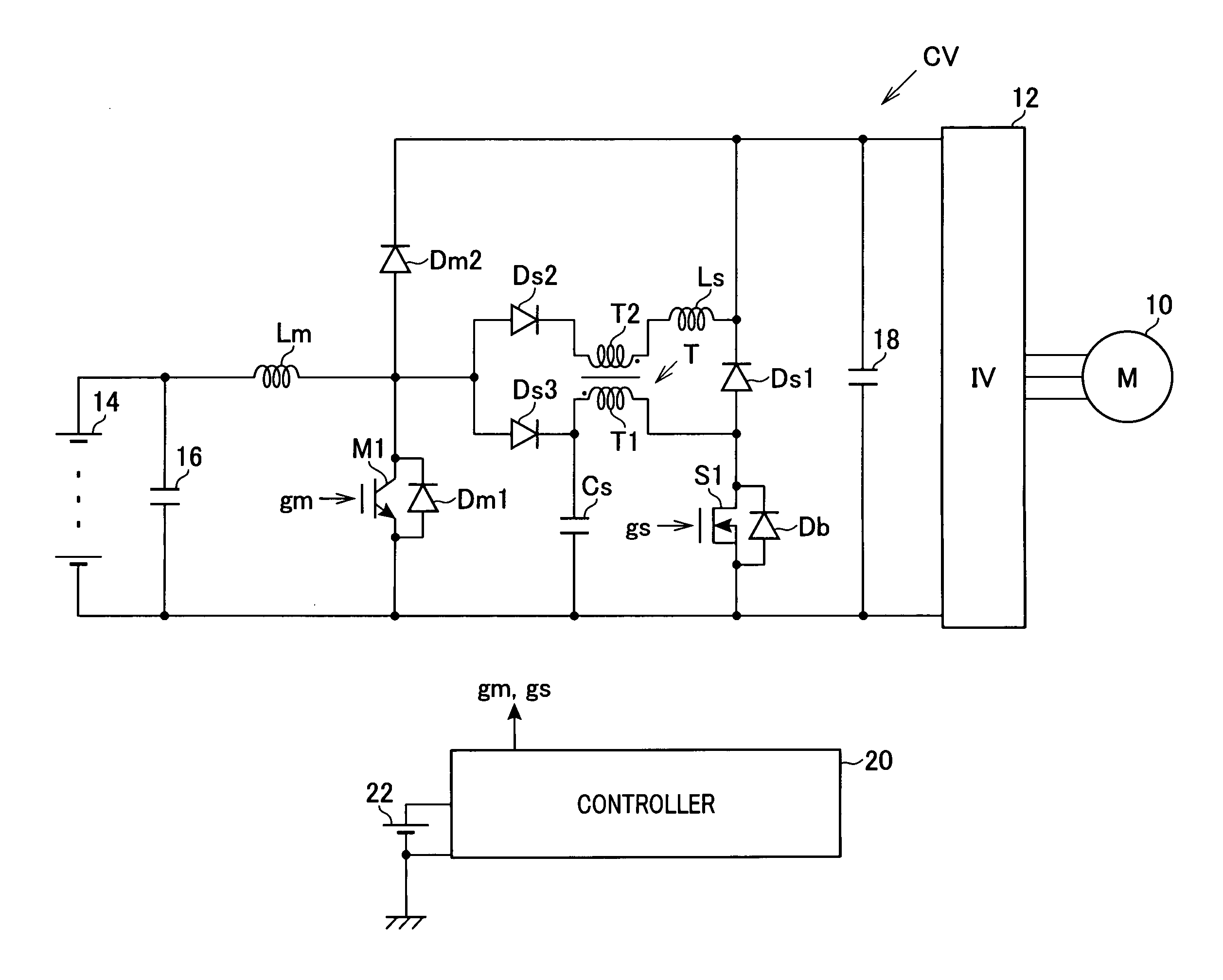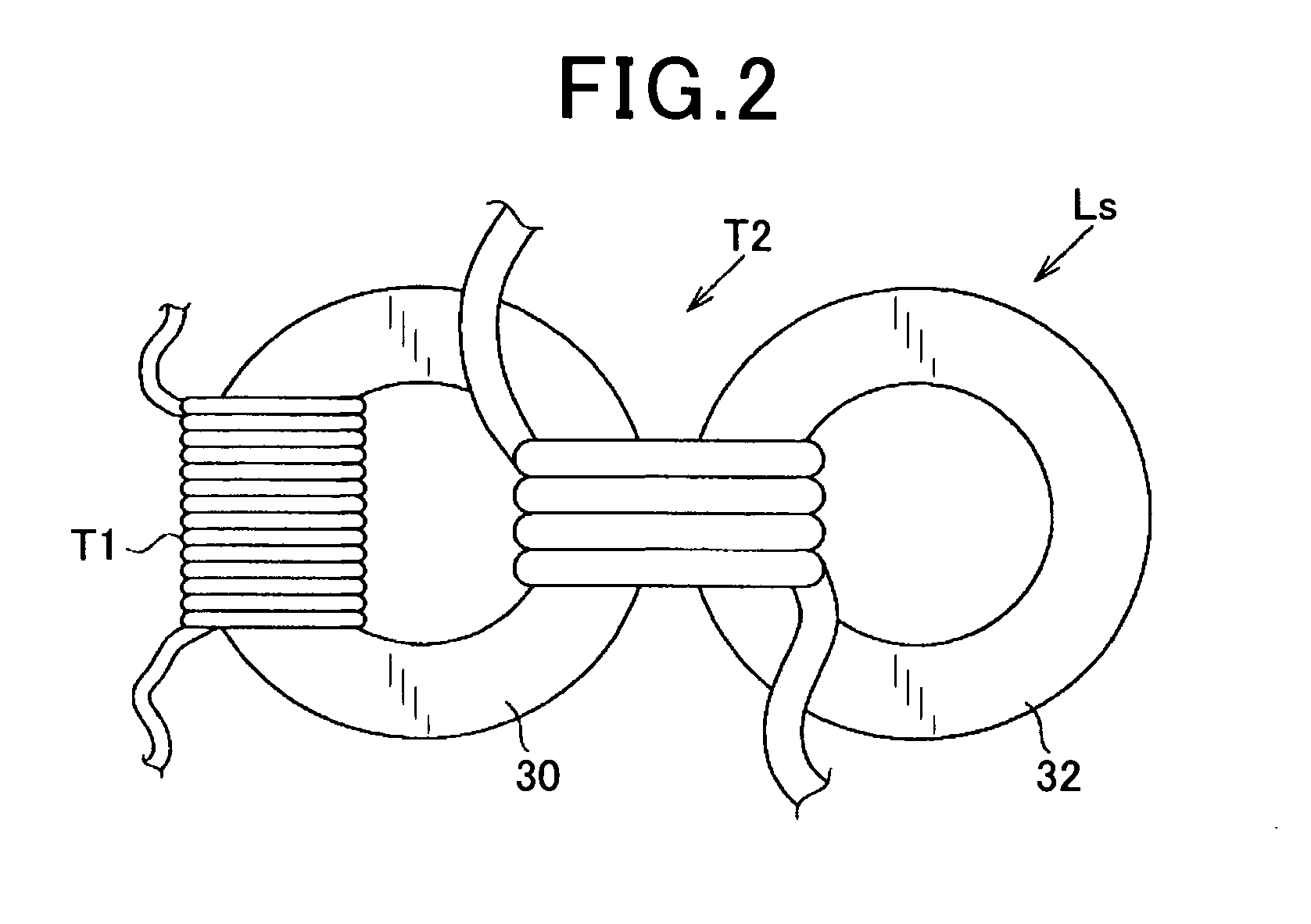Power converter with high efficiency in operation
a technology of power converter and high efficiency, which is applied in the direction of electric variable regulation, process and machine control, instruments, etc., can solve the problems of increasing switching loss, reducing the efficiency of power converter operation, and occupying passive components of the magnetic part a considerable part of the size of the power converter
- Summary
- Abstract
- Description
- Claims
- Application Information
AI Technical Summary
Benefits of technology
Problems solved by technology
Method used
Image
Examples
first embodiment
[0039]Referring to the drawings, wherein like reference numbers refer to like parts in several views, particularly to FIG. 1, there is shown a converter control system designed to control an operation of a power converter CV which is used in driving a main engine mounted in an automotive vehicle.
[0040]An electric motor-generator 10 is used as the main engine of the vehicle and has an output shaft connected mechanically to driven wheels (not shown) of the vehicle. The motor-generator 10 is joined electrically to a high-voltage battery 14 and a smoothing capacitor 16 through an inverter 12 and the converter CV. The converter CV is equipped with a sub-circuit to reduce the switching loss in a chopper circuit. Specifically, the converter CV includes a main circuit equipped with a main switch M1, a main diode Dm1 connected in inverse-parallel to the main switch M1, and a main diode Dm2 connected in series with the main switch M1 and the main diode Dm1. The converter CV also includes a m...
second embodiment
[0092]The power converter control system of the second embodiment offers an additional beneficial advantage below in addition to the advantages 1) to 7).
[0093]8) The converter CV is designed to have the capacitor which is connected in parallel to the main switch M1 and whose capacitance is variable. Specifically, when the current flowing through the main inductor Lm changes greatly, the controller 20 works to change the total capacitance of the capacitors Cs1 and Cs2, thus optimally controlling the speed at which the voltage across the ends (i.e., the collector and the emitter) of the main switch Ml increases when the main switch M1 is turned off.
[0094]The converter control system of the third embodiment will be described below with reference to FIG. 10 which is a modification of the first embodiment. The same reference numbers as employed in FIG. 1 will refer to the same parts, and explanation thereof in detail will be omitted here.
[0095]The converter CV is designed to have the sub...
fourth embodiment
[0098]The converter control system of the fourth embodiment will be described below with reference to FIG. 11. The same reference numbers as employed in FIG. 1 will refer to the same parts, and explanation thereof in detail will be omitted here.
[0099]The converter CV is designed to have two sub-circuits installed in a bi-directional step-up chopper circuit. The bi-directional step-up chopper circuit is made up of two structures one of which is the same as that of the step-up chopper circuit of the first embodiment and other of which is the same as that of the step-down chopper circuit of the third embodiment. The sub-circuits are provided one for each of the main switches M1 and M2.
[0100]When it is required to step-up the current to be outputted from the high-voltage battery 14 to the capacitor 18, a lower circuitry (i.e., a lower one of the sub-circuits) of the bi-directional step-up circuit, as viewed in the drawing, which is equipped with the capacitor Cs connected in parallel to...
PUM
 Login to View More
Login to View More Abstract
Description
Claims
Application Information
 Login to View More
Login to View More - R&D
- Intellectual Property
- Life Sciences
- Materials
- Tech Scout
- Unparalleled Data Quality
- Higher Quality Content
- 60% Fewer Hallucinations
Browse by: Latest US Patents, China's latest patents, Technical Efficacy Thesaurus, Application Domain, Technology Topic, Popular Technical Reports.
© 2025 PatSnap. All rights reserved.Legal|Privacy policy|Modern Slavery Act Transparency Statement|Sitemap|About US| Contact US: help@patsnap.com



